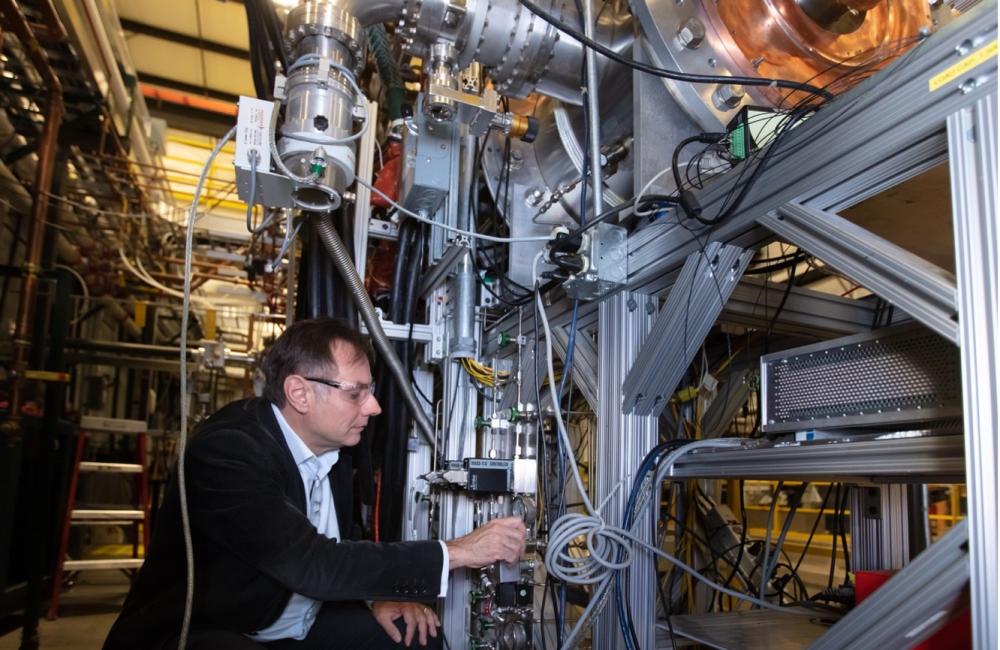Juergen Rapp, chief scientist for the Material Plasma Exposure eXperiment (MPEX), checks device settings on Proto-MPEX prior to its end of operations in April. Photo: ORNL
The prototype of the Material Plasma Exposure eXperiment (Proto-MPEX) at Oak Ridge National Laboratory officially wrapped up its research operations in late April, after almost seven years of service.
“Proto-MPEX delivered multiple first-of-a-kind demonstrations that are key to the development of world-leading linear plasma devices for advancing the science of plasma material interactions in fusion,” said Juergen Rapp, MPEX chief scientist.
As a forerunner of the Material Plasma Exposure eXperiment (MPEX) now preparing for construction, Proto-MPEX helped set the foundation for the science of plasma material interactions (PMI). The device also supported development of research techniques for study of materials capable of withstanding the extreme conditions inside fusion reactors. In fusion environments, subatomic particles are subjected to temperatures hotter than the center of the Sun and magnetic fields hundreds of thousands of times stronger than the Earth’s.
Since beginning operations in May 2014, scientists executed close to 30,000 plasma pulses in Proto-MPEX. These activities provided a wealth of data that have yielded more than 56 publications to date. At least half a dozen graduate students contributed to the research.
One important accomplishment on Proto-MPEX was testing of a novel heating concept called electron Bernstein wave heating (EBW), that allows for a wave to be absorbed in a very high-density magnetized plasma produced by a powerful helicon. This heating method requires rigorous, precise calculations and had not been tried before, said Rapp.
“Launcher precision are the key words here,” he said. “Other concepts don’t approach the same problem this way, and the fact that we were able to test it successfully is one of the contributions of Proto-MPEX.”
Another significant achievement was the successful demonstration for the first time of ion heating in a high-density linear plasma. But as successful as the prototype was, it also opened new questions for the team, specifically about the materials used to reduce impurities.
“Our initial plan was to use a thin tungsten layer to cover the cylindrical ceramic helicon window of the plasma source to reduce the release of impurities. This worked but it caused the resulting plasma to be weak. Moving forward, we’ll need to find a different solution for reducing either the impurity sources or the transport of the impurities from the source to the target, so that our PMI studies will not be influenced by those impurities,” explained Rapp.
Proto-MPEX will now be disassembled and stored to make space for the construction of MPEX, a linear plasma device to study PMI at levels consistent with future fusion power reactors. The team, however, hopes to reconfigure components from Proto-MPEX later in a different space, to continue their work on the science of PMI.
“We hope to support continued research in the reduction of impurity sources, heating physics, improved diagnostics, and component lifetimes. Together with MPEX we can accelerate our understanding of PMI science,” said Rapp.
Scientific resourcefulness
Proto-MPEX received support from ORNL’s Laboratory Directed Research and Development (LDRD) program and DOE’s Office of Science.
To build Proto-MPEX, the team reutilized pieces from retired fusion devices, such as the ELMO Bumpy Torus (EBT) experiment, a device first built in 1973 to study plasma heating and equilibrium in closed magnetic field-line systems. EBT was designed with the concept of plasma heating and confinement over electron rings, with state-of-the-art magnetic field coils that were specifically designed for it. After the project was decommissioned in the 1980s, ORNL retained various components, including 13 of the magnet coils which were later used in designing the initial pieces of Proto-MPEX in 2010.
The team also tapped into other retired devices for components, including two power supplies previously belonging to the Advanced Toroidal Facility (ATF), an ORNL project recognized as one of the world’s largest stellarator experiments built in the 1980s.
Additionally, the team reused gyrotrons from both EBT and ATF, and then built and custom-ordered other components, such as vacuum pieces and plasma-facing components, some of which were acquired through international collaborations.
The use of refurbished components in the design and construction of new fusion devices has been used before in other countries. The Netherlands employed this concept when building both Pilot-PSI, the forerunner of Magnum-PSI, a linear plasma device capable of replicating the expected exhaust system, or divertor, conditions at ITER. When MPEX begins experiments, scientists will be looking closely at the way plasma interacts with the potential divertor materials for a fusion pilot plant.
—Andrea Schneibel
UT-Battelle LLC manages Oak Ridge National Laboratory for DOE’s Office of Science, the single largest supporter of basic research in the physical sciences in the United States. DOE’s Office of Science is working to address some of the most pressing challenges of our time. For more information, visit https://energy.gov/science.



